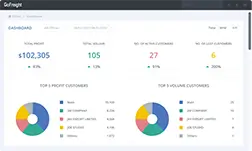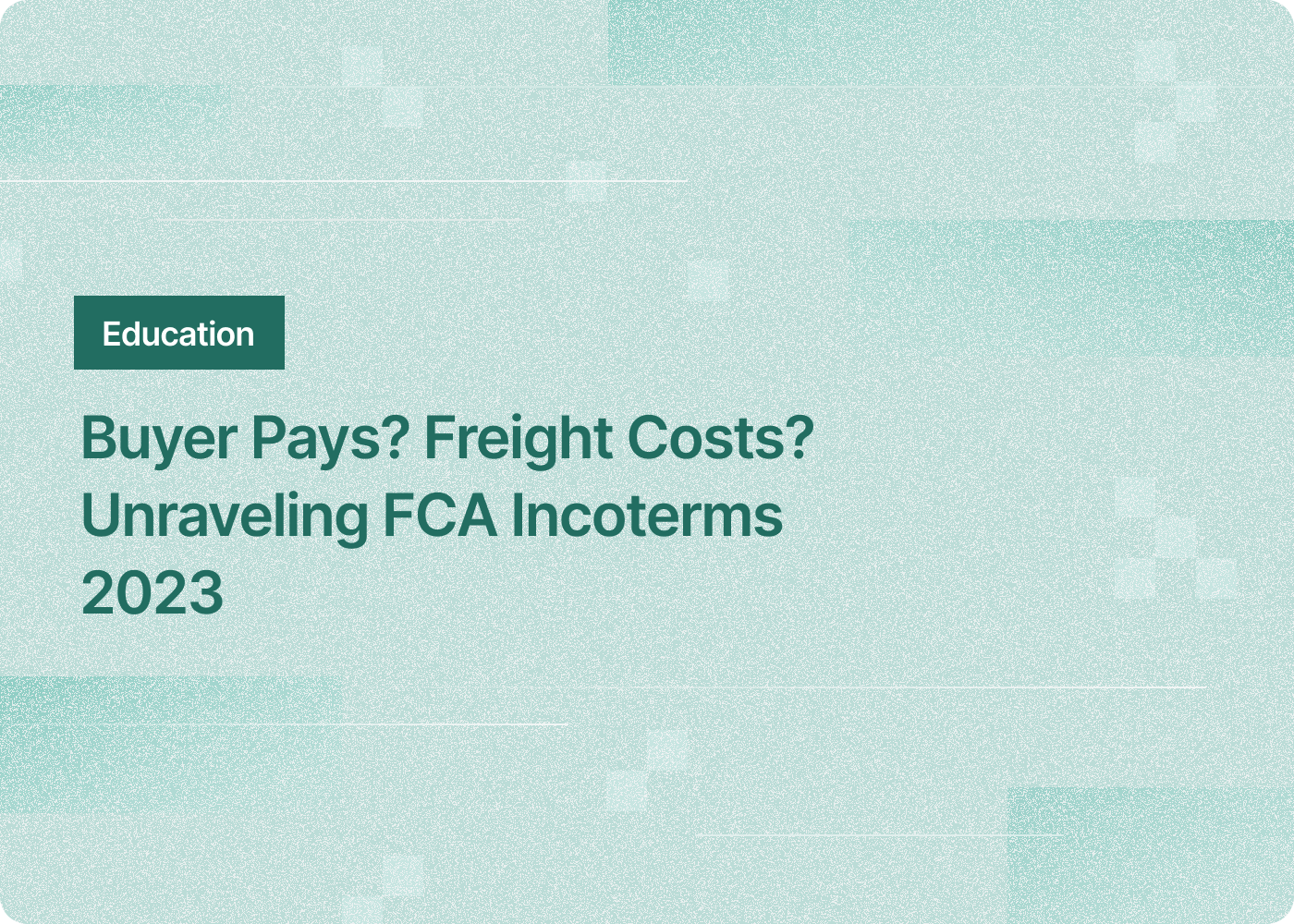In the constantly evolving world of international trade, understanding the intricacies of shipping terms can be the difference between seamless transactions and costly misunderstandings. Among the myriad of terms that pepper the landscape of international transactions, FCA Incoterms stand out. But what exactly are these incoterms?
FCA Incoterms, short for “Free Carrier,” represent a set of international commercial terms used in international and domestic trade contracts. These terms define the responsibilities of buyers and sellers in the agreement: who arranges and pays for transportation, insurance, import clearance, and other logistics. While FCA Incoterms have been a cornerstone of international trade for years, the dynamics in 2023 have added newer layers to its understanding.
The year 2023 has ushered in significant changes in the realm of international trade. From the shifting sands of global politics to the challenges of post-pandemic economies, the manner in which goods are transported, insured, and handed over has transformed. This makes the understanding of FCA shipping terms all the more critical for businesses, freight forwarders, and shippers.
As we proceed, we’ll delve deeper into the responsibilities, benefits, and challenges associated with FCA Incoterms 2023. Whether you’re a seasoned trader familiar with the nuances of sea freight and export formalities, or a newcomer navigating the complexities of international shipping, this exploration promises clarity and insights to equip you for success.
Understanding FCA: The Basics of Free Carrier
The labyrinth of international trade often feels overwhelming, especially when trying to discern between the different shipping terms and Incoterms. Central to this complex network is the FCA Incoterm or Free Carrier. Let’s unravel its basics.
The Meaning and Importance of “Free Carrier” in International Shipping
Free Carrier (FCA) is one of the predefined commercial terms published by the International Chamber of Commerce (ICC) that elucidate the tasks, costs, and risks involved in the delivery of goods from sellers to buyers. Specifically, FCA dictates that the seller delivers the goods to a named place (often the seller’s premises or a shipping terminal) where a carrier nominated by the buyer takes charge.
The significance of the FCA term lies in its flexibility. It’s applicable to any mode of transport, be it sea transport, inland waterway transport, or a multimodal shipping process. Moreover, with FCA, buyers gain a clearer picture of the shipping process, knowing when their responsibility for the goods commences. This is critical for ensuring timely insurance, appropriate freight arrangements, and smooth import formalities.
Differentiating FCA from Other Incoterms
Each Incoterm plays a distinct role in international transactions, with FCA emphasizing the point where the risk transfers from seller to buyer. Unlike terms like Delivered Duty Paid (DDP), where the seller remains responsible for all costs and risks till the goods reach their final destination, FCA places the onus of risk on the buyer once the goods are handed to the carrier.
Another term, Carriage Paid To (CPT), might seem similar to FCA, but while CPT requires the seller to pay for the transport, FCA allows the buyer to nominate the carrier, offering greater control over transportation modes involved.
By understanding the nuances of FCA in comparison to other Incoterms, businesses can make informed decisions, optimizing costs and reducing potential risks in their international transactions.
Buyer’s Responsibilities: Decoding What the “Buyer Pays”
In the realm of international trade, responsibilities are often divided between the buyer and seller. The FCA Incoterms make this division clear, especially outlining what the buyer is expected to handle. Let’s take a closer look at the specifics of these obligations.
Breaking Down the Costs: Freight, Insurance, Terminal Charges, and More
Under the FCA Incoterm, a plethora of costs fall under the buyer’s domain:
Freight Costs: Once the goods are delivered to the specified location (usually the terminal or seller’s premises), the buyer assumes the responsibility for all subsequent freight costs, be it sea freight or inland transport.
Insurance Costs: FCA doesn’t mandate the buyer to obtain insurance, but it’s wise to do so. Any risks post the delivery point are the buyer’s to bear, making insurance a safeguard against potential mishaps.
Terminal Charges: These can include loading and unloading charges at shipping terminals. Given that the FCA point often is at a terminal, costs associated post that delivery are on the buyer.
Import Clearance and Duties: Once the goods arrive in the buyer’s country, all import formalities, duties, and related costs are the buyer’s responsibility.
Transportation and Terminal Charges: From the point of delivery, any additional costs related to transportation and terminal charges are borne by the buyer.
The Role of the Buyer in Arranging Transportation and Insurance
Under the FCA shipping terms, the buyer plays a pivotal role in ensuring the goods reach their destination post the FCA delivery point:
Choosing the Carrier: The buyer has the flexibility to nominate the carrier responsible for transporting the goods, whether they opt for a trusted freight forwarder or a specific shipping line.
Arranging Local Transport: This involves coordinating the movement of goods from the FCA point to their final destination, which may include local transport or additional sea transport.
Securing Insurance: While not obligatory, it’s in the buyer’s best interest to secure insurance for the goods. This involves liaising with insurance firms, understanding coverage, and ensuring the merchandise transfers are protected against unforeseen events.
In essence, the “Buyer Pays” in the FCA framework encompasses a comprehensive range of responsibilities and costs. By understanding these, buyers can better plan their budgets, ensure timely deliveries, and safeguard their investments in international trade.
The Seller’s Role: From Pre-shipment Inspection to Delivery
The FCA Incoterms, overseen by the International Chamber of Commerce, elucidate the responsibilities of both buyers and sellers in international trade. In this framework, the seller’s role is paramount, encompassing various duties from the early stages of the transaction to the actual delivery of goods.
The Importance and Process of Pre-shipment Inspection
In line with the FCA shipping terms, the pre-shipment inspection stands out as a pivotal step. But what is it, and why is it critical?
Quality Assurance: This process ensures the goods align with the agreed-upon specifications, a step that safeguards both parties. No buyer wants a surprise when unboxing their shipment.
Document Verification: As part of the export and documentation tasks, the seller validates documents like the bill of lading, transport document stating the goods’ condition, and others, ensuring transparency in the shipping process.
Regulatory Compliance: Adhering to both the seller’s home country and the export country’s requirements, this inspection confirms that export formalities and export clearance are appropriately managed.
How the Seller Remains Liable Until Goods are Handed to the First Carrier
While the term “Free Carrier” suggests freedom for the seller post-delivery, the FCA Incoterm clarifies that the seller remains liable until the goods reach the first transportation point. This could be the seller’s premises, a freight forwarder’s warehouse, or a shipping terminal.
Liability Transfer: The risk transfers from the seller to the buyer once the goods are handed over to the carrier chosen by the buyer. Until that point, any mishaps, damages, or losses are on the seller’s tab.
Shipping Preparation: Before this transfer, the seller is in charge of export packaging, ensuring goods are safely prepared for sea transport or other transportation modes involved.
The Interplay Between Seller’s Responsibilities and the Buyer’s Payment
Understanding the financial dynamics is vital:
Payment Structures: Often, credit payments or agreed-upon payment structures dictate when the buyer pays. With the FCA shipping terms, once the seller delivers the goods to the designated point and completes the pre-carriage requirements, they usually present the transport document to the buyer as proof, triggering the payment process.
Cost Assumptions: While the seller handles costs related to pre-shipment inspection, export duties, and ensuring goods are ready for transport, they might recoup these in the product’s price. Once the seller’s responsibilities are met, freight costs, insurance costs, and other subsequent expenses are what the “buyer pays.”
To sum it up, while the FCA Incoterm offers clarity, it’s the intricate dance of responsibilities, risks, and costs between the seller and buyer that ensures smooth international transactions. Both parties need to be well-acquainted with their roles for successful trade outcomes.
FCA Shipping: Advantages of the Free Carrier FCA System
The world of international trade is a dynamic landscape with varying shipping terms that cater to different needs. Among these, the Free Carrier FCA system stands tall as an increasingly sought-after arrangement. But what makes it the go-to choice for many in the realm of international transactions?
Why FCA is Becoming Increasingly Popular in International Trade
Flexibility: One of the primary reasons for its rise in popularity is the flexibility FCA offers. Whether it’s sea transport, inland waterway transport, or another method, the FCA Incoterm can accommodate various transportation modes involved.
Simplicity in Documentation: With FCA shipping, the seller provides the transport document, such as a bill of lading or a transport document stating the handover point. This centralized approach reduces confusion and expedites the shipping process.
Cost Transparency: Both parties have a clear understanding of their financial responsibilities. From loading charges in the seller’s home country to terminal charges on the buyer’s end, every cost is clearly outlined, ensuring no hidden surprises.
Risk Management Under FCA Terms: Transfer Points, Liability, and Insurance
Risk management is a paramount concern in international trade. Thankfully, the FCA system offers robust mechanisms:
Defined Transfer Points: Clarity is the essence of FCA shipping. With specified destinations outlined in the agreement, such as a forwarder’s warehouse or shipping terminal, both parties are aware of the exact point where risks transfer.
Liability Demarcation: As discussed, the seller remains liable until goods are handed to the first carrier. This clear demarcation ensures both the seller and buyer are aware of their responsibilities, from the point the merchandise transfers to the point the buyer assumes responsibility.
Insurance Dynamics: Often, insurance costs are borne by the buyer under FCA terms. The buyer can either arrange their own insurance or request the seller to do so, with the costs subsequently reimbursed. This flexibility means the buyer can tailor the insurance to their needs, potentially getting better coverage or rates.
To wrap it up, the FCA Free Carrier system shines as a beacon of clarity, flexibility, and risk management in the vast sea of shipping incoterms. For businesses seeking a streamlined, transparent, and adaptable shipping method, FCA is indeed a worthy consideration.
Deciphering the Documentation: Essential Paperwork for FCA Shipping
In the intricate tapestry of international trade, documentation stands as a crucial thread, holding together the entire fabric. Especially under FCA shipping terms, the proper paperwork ensures goods travel seamlessly across borders, reduces potential disputes, and upholds legal clarity. Let’s delve into the cornerstone documents for FCA shipping and understand their quintessential roles.
The Role of Bills of Lading, Transport Documents, and Export Clearance
Bills of Lading (BOL): These are perhaps the most fundamental documents in the shipping line. A BOL acts as a receipt for shipped goods, a contract between the freight carrier and shipper, and a document of title. Especially under FCA incoterm agreements, the BOL confirms the seller’s successful handover of goods to the first carrier, making it a pivotal transport document.
Transport Documents: Beyond the BOL, other transport documents play vital roles. For instance, in FCA shipping, there might be a transport document stating the handover point. These documents, be it for sea transport or inland waterway transport, offer proof of the contract of carriage and ensure all parties are aligned on transportation modes involved.
Export Clearance: Essential for FCA, this ensures the exported goods comply with local regulations in the seller’s country. It includes paperwork for export duty, other export formalities, and sometimes specific export packaging guidelines. Ensuring export clearance smoothens the path for goods as they exit the export country and head towards their destination.
How Proper Documentation Reduces Risks and Facilitates Smoother Transactions
Accurate and comprehensive documentation serves as a bedrock for smooth international transactions. It minimizes the chances of delays at customs, prevents potential disputes over shipment specifics, and safeguards both buyers and sellers from unforeseen liabilities. By reducing ambiguities, the FCA shipping paperwork creates a transparent environment where all parties are on the same page, ensuring goods move efficiently from the seller’s premises to the specified destination.
In conclusion, while paperwork might seem tedious, its paramount importance in FCA shipping is undeniable. Proper documentation is, after all, the linchpin of successful international trade.
Risks and Transitions: From the Seller’s Premises to the Specified Destination
FCA shipping terms, under the guidance of the International Chamber of Commerce’s international commercial terms, offers a clear roadmap on the transitions of goods in international trade. The linchpin of this is understanding when and where the risk transfers from the seller to the buyer, particularly from the seller’s premises to the specified destination.
Understanding When the Risk Transfers from the Seller to the Buyer
Under FCA incoterms, the moment of liability transfer, or when the buyer assumes responsibility, is crisply defined. Once the seller delivers the goods, having cleared them for export, to the freight forwarder or directly to the transportation point specified by the buyer, the risk transfers. From this point onwards, the buyer’s risk predominates. It includes all costs, potential damages, or losses incurred beyond this transfer point. The seller remains liable only up to the moment the goods are handed over, as detailed in the bill of lading or other relevant transport documents.
The Significance of the Specified Destination in FCA Terms
The specified destination in FCA shipping plays a pivotal role. This could be the seller’s own warehouse, a forwarder’s warehouse, a shipping terminal, or any other agreed-upon point. It’s here that the goods are deemed delivered by the seller, and where the buyer starts its journey of arranging local transport, dealing with import formalities, and handling subsequent transport costs.
Furthermore, this destination holds paramount importance in the shipping process, as it delineates the boundary of seller’s responsibilities. It’s where export clearance is confirmed, ensuring that the goods have met all export formalities of the seller’s home country. From this point on, freight forwarders, arranged by the buyer, take the baton, navigating the intricacies of international transactions and sea transport, under the buyer’s guidance and cost.
In summation, FCA shipping unambiguously demarcates the territories of responsibilities, from pre-carriage duties at the seller’s premises to eventual arrival at the specified destination. Understanding these transitions ensures that both parties are safeguarded, costs are clearly allocated, and international trade proceeds with optimal efficiency.
Why the Clarity on FCA Incoterms Matters in 2023
As the dynamics of international trade evolve, the 2023 iteration of FCA incoterms stands as a beacon of clarity amidst the ebb and flow of global commerce. For businesses and traders, understanding these terms is no longer a mere accessory but a necessity. With the expansive global market landscape, being equipped with knowledge on FCA can make or break a deal, offering an edge in negotiations and ensuring the avoidance of potential pitfalls.
FCA’s specificity serves as a robust framework, guiding parties through the intricate alleys of international transactions. Whether it’s discerning the subtle nuances of liability transfers or the gravity of the specified destination, FCA offers a roadmap. This, in turn, fortifies businesses against unforeseen costs, fostering trust between traders and minimizing disputes.
Ultimately, the reverberations of FCA’s clarity echo beyond mere documentation. It’s about crafting informed choices in international transactions, enabling businesses to navigate the waters of 2023’s international trade with confidence and precision. In this age, where every decision can impact a company’s bottom line, understanding FCA incoterms is the compass every trader needs.





